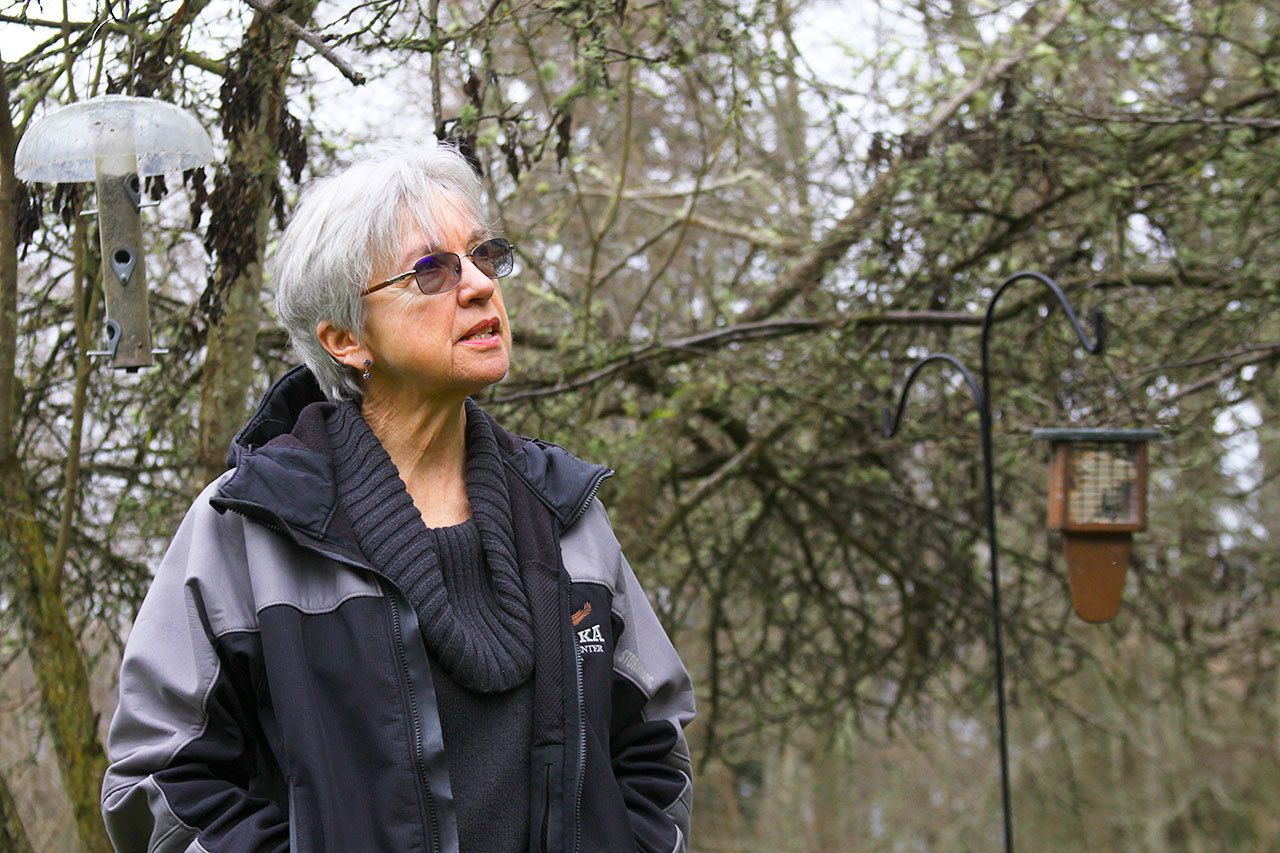On a sloping piece of wooded property at the end of Towhee Lane, wild birds enjoy a little slice of paradise.
Aside from abundant natural cover to escape from birds of prey, the property also is home to several feeding stations and two caring residents who go to great lengths to keep their feathery friends happy.
Linda Bainbridge has counted more than 90 different bird species over the years from her Greenbank property, including a tiny one that can be both a blessing and a curse this time of year when temperatures drop below freezing.
When those bitter conditions revealed themselves last week, Bainbridge revisited an old routine of bringing in her hummingbird feeder at night and rising before dawn to return it to her porch.
This method allows the sweet liquid inside the feeder to thaw overnight and be ready for the Anna’s Hummingbirds that frequent Bainbridge’s back deck.
“At the first glimmer of light, the hummers are out there,” Bainbridge said. “I set my alarm for 7 a.m., get out and set the feeder and then go back to bed.”
Swapping out hummingbird feeders is just one example of the steps some bird lovers will take to help birds during the winter.
Bainbridge, who is the membership chair of the Whidbey Audubon Society, personally believes that birds benefit from a little human intervention, especially during the chilly winter months.
And if the birds don’t benefit, she certainly does.
“I think of it as something I do for my own enjoyment,” she said. “I think it does probably help birds when they’re stressed out in the winter when conditions are hard for them, especially when snow is on the ground and food is scarce.
“From what I read, feeding probably benefits individuals but probably doesn’t affect the population of birds where you’re ultimately going to save the species. It adversely could be helping rodents. That’s why some people don’t like to feed birds.”
The methods used by Bainbridge and her husband Gordon aren’t done without careful thought.
She considers the type of feeder that best impacts the targeted species as well as the safest place to put a feeder to help prevent window strikes and to protect them from predators.
She’s found tube feeders to be better than platform feeders because there is less seed kicked to the ground. She places her feeders under or near natural cover to give birds a place to flee from swooping birds of prey such as the Cooper’s Hawk that frequents her property.
She’s seen birds scatter in a panic by the presence of hawks.
“I’ve read you should put your feeder within 3 feet of a window,” Bainbridge said. “That way, they can’t gather up enough speed to bang into it. Or alternatively, 30 feet or more away.”
Bainbridge and her husband take one extra unorthodox step to help keep the birds on their property safe.
They walk Percy and Isabel, their cats, on a leash and otherwise keep them indoors.
Outside of habitat loss, a leading cause of bird deaths is attributed to outdoor cats that roam freely, Bainbridge said.
Window strikes is another high mortality factor.
“I would definitely tell people not to feed birds if they have an outdoor cat,” Bainbridge said. “If you see strays on your property, I wouldn’t feed the birds. Then you’re setting up a killing station.
“My husband never thought he’d be walking a cat, but he does.”
Steve Ellis, an avid birder from Coupeville, said he sees nothing wrong with feeding birds to help them through the winter.
He starts feeding them in December then stops in the spring when the weather starts to warm up.
Ellis said he stops feeding birds in the spring in part because the seed attracts Brown-headed Cowbirds, which will lay their eggs in other native birds’ nests.
Ellis feeds birds in moderation so there’s nothing left for rodents come evening time.
“The very best thing people can do is to just have a yard full of natural trees and shrubs,” Ellis said, pointing to the seeds from firs and alders as examples and the insects that come with them. “That way they can find their own food and own shelter and don’t have to rely on you so much.”
Ellis and Bainbridge emphasize the importance of regularly cleaning feeders to minimize the spread of diseases.
Bainbridge likes to clean her feeders at least every other week and recommends bleach to kill germs.
The seed she uses for birds year-round is black oil sunflower seeds, which is high in fiber, fat and oils, helping birds combat the cold.
Another winter mainstay are suet blocks, which are high in fat.
“What they’re looking for is something to help them keep their energy levels up,” said Bob Olson, owner of Whidbey Wild Bird in Oak Harbor.
“That’s how they generate their body heat. At night, when they’re not feeding, they’ve got to have that fiber and oils and protein to keep them going.”
To survive severe bouts of cold weather, hummingbirds are able to lower their body temperatures at night by entering a dormancy state known as torpor. During this process, sugars are converted to fat.
At first light, hummingbirds come out of torpor to feed and can get into trouble if no food source is available.
This is why Bainbridge sets the alarm on her cell phone to 7 a.m. this time of year.
“They wake up and first thing in the morning, they need that energy,” she said. “They need that sustenance.
“I know friends who are traveling who decide not to feed hummingbirds in the winter because of the idea that they would be abandoning them.”
So if you start, don’t stop.
“I think of it as a winter-long commitment,” Bainbridge said.



